Organisational Behaviour Report: Siemens' Culture and Motivation
VerifiedAdded on 2020/12/26
|16
|4307
|402
Report
AI Summary
This report, prepared by Jamal Uddin for Siemens' management team, analyzes organisational behaviour within the company, focusing on the influence of culture, politics, and power on employee behaviour. It delves into Siemens' culture, highlighting its teamwork-oriented approach and the application of Handy's cultural model. The report also evaluates content and process theories of motivation, specifically Maslow's hierarchy of needs and Adam's Equity theory, and their impact on achieving organizational goals. Furthermore, it examines what constitutes an effective team within Siemens and applies the Path-Goal Theory of leadership to achieve sales targets. The analysis provides insights into how these elements affect the company's performance and employee engagement.
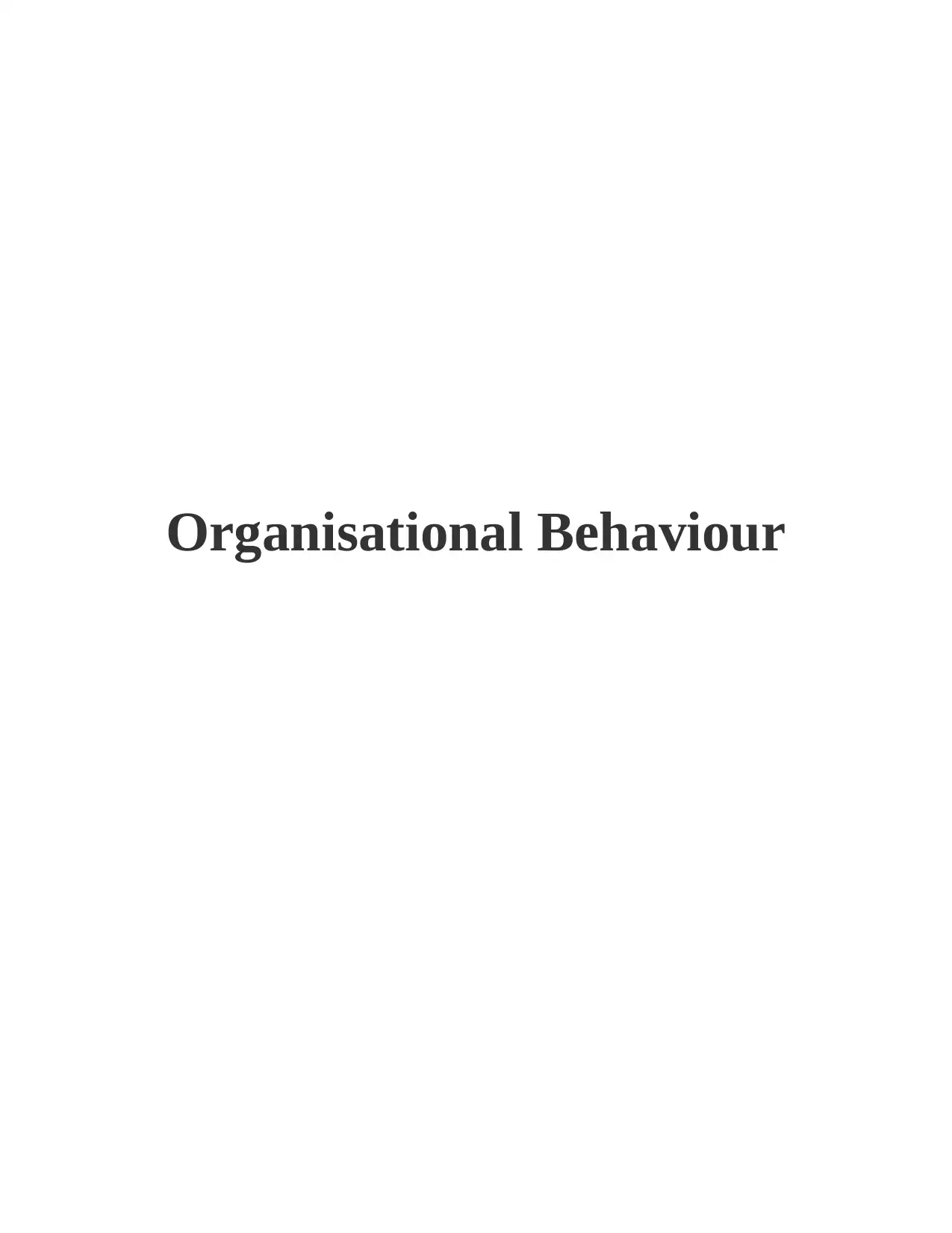
Organisational Behaviour
Paraphrase This Document
Need a fresh take? Get an instant paraphrase of this document with our AI Paraphraser
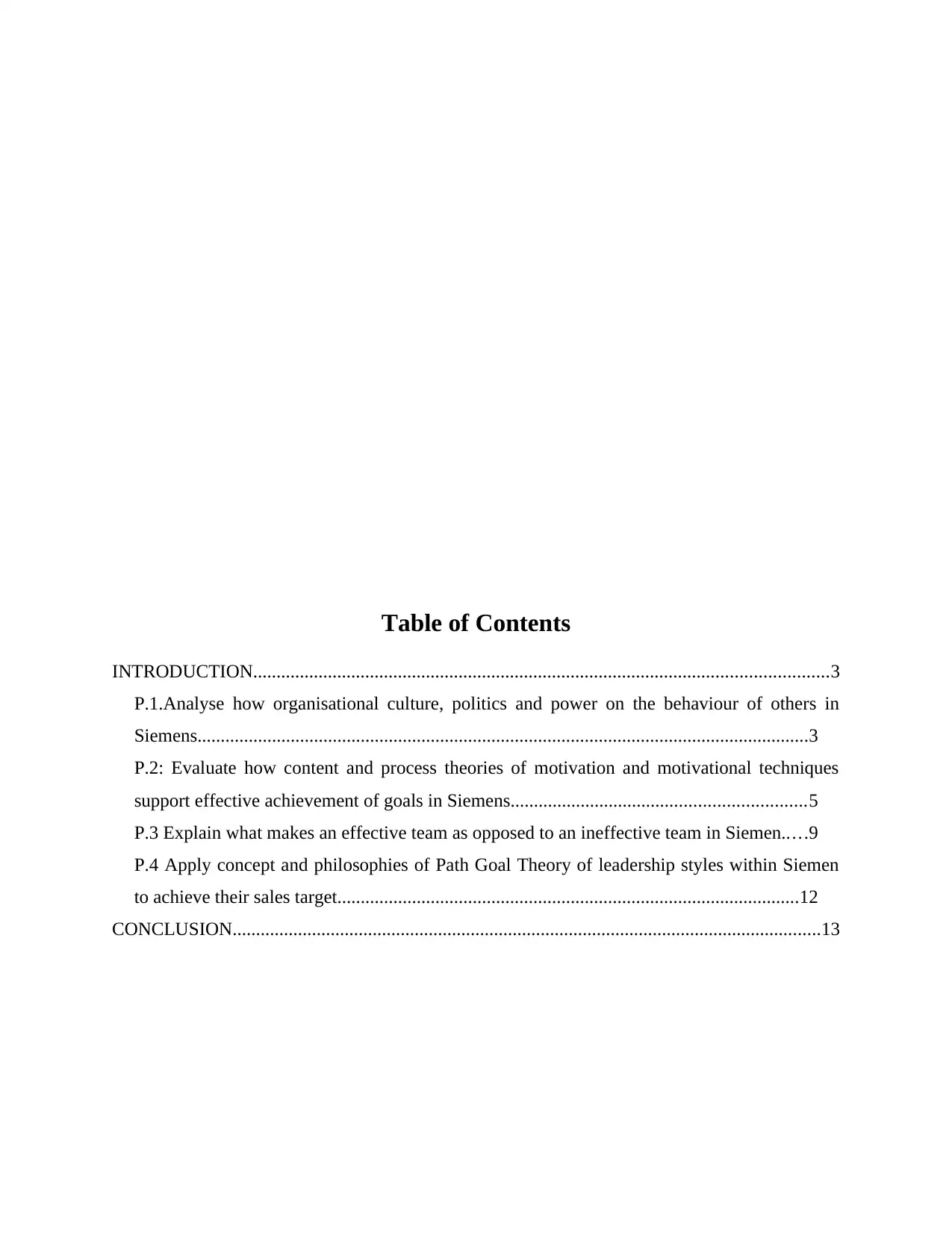
Table of Contents
INTRODUCTION...........................................................................................................................3
P.1.Analyse how organisational culture, politics and power on the behaviour of others in
Siemens...................................................................................................................................3
P.2: Evaluate how content and process theories of motivation and motivational techniques
support effective achievement of goals in Siemens...............................................................5
P.3 Explain what makes an effective team as opposed to an ineffective team in Siemen.....9
P.4 Apply concept and philosophies of Path Goal Theory of leadership styles within Siemen
to achieve their sales target...................................................................................................12
CONCLUSION..............................................................................................................................13
INTRODUCTION...........................................................................................................................3
P.1.Analyse how organisational culture, politics and power on the behaviour of others in
Siemens...................................................................................................................................3
P.2: Evaluate how content and process theories of motivation and motivational techniques
support effective achievement of goals in Siemens...............................................................5
P.3 Explain what makes an effective team as opposed to an ineffective team in Siemen.....9
P.4 Apply concept and philosophies of Path Goal Theory of leadership styles within Siemen
to achieve their sales target...................................................................................................12
CONCLUSION..............................................................................................................................13
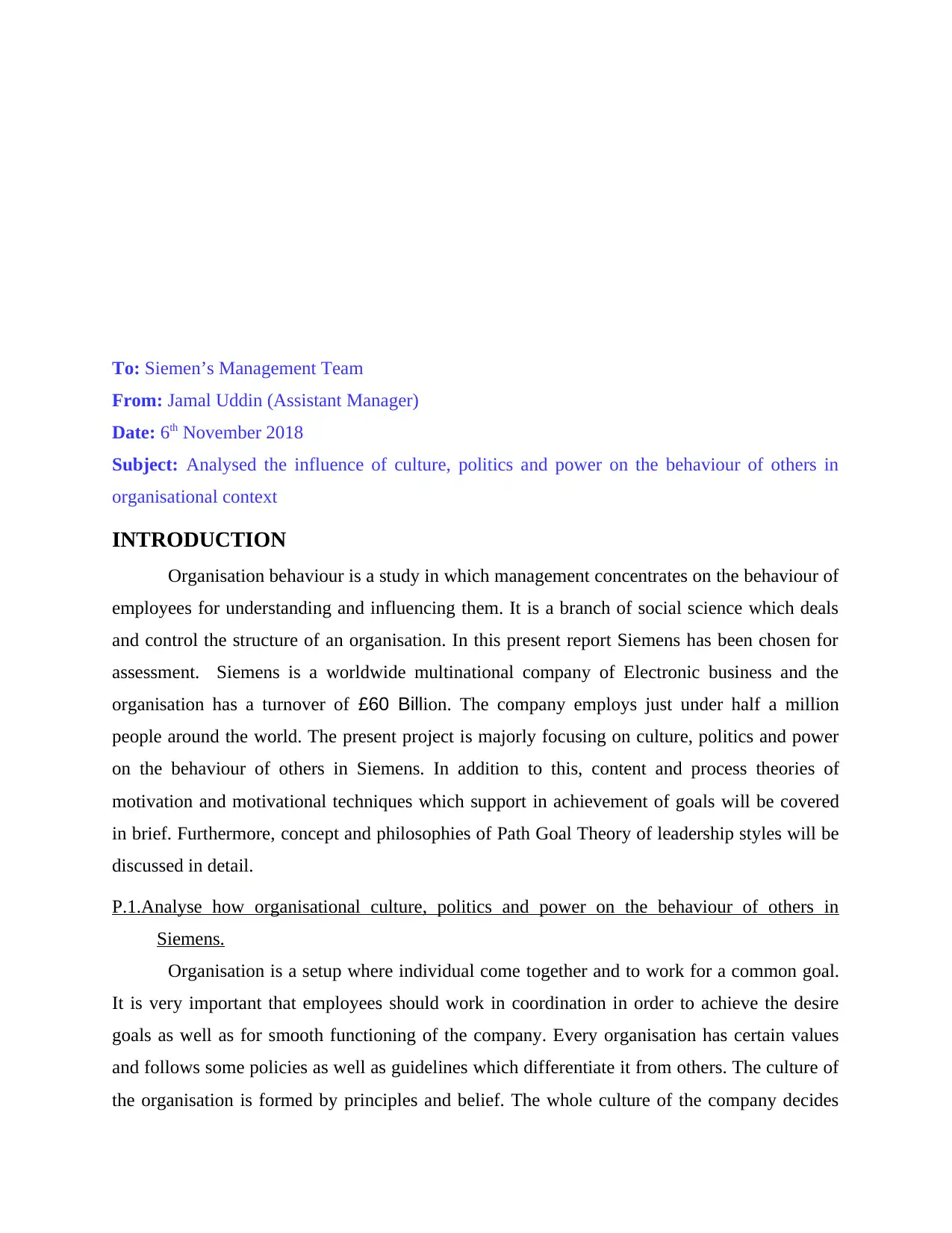
To: Siemen’s Management Team
From: Jamal Uddin (Assistant Manager)
Date: 6th November 2018
Subject: Analysed the influence of culture, politics and power on the behaviour of others in
organisational context
INTRODUCTION
Organisation behaviour is a study in which management concentrates on the behaviour of
employees for understanding and influencing them. It is a branch of social science which deals
and control the structure of an organisation. In this present report Siemens has been chosen for
assessment. Siemens is a worldwide multinational company of Electronic business and the
organisation has a turnover of £60 Billion. The company employs just under half a million
people around the world. The present project is majorly focusing on culture, politics and power
on the behaviour of others in Siemens. In addition to this, content and process theories of
motivation and motivational techniques which support in achievement of goals will be covered
in brief. Furthermore, concept and philosophies of Path Goal Theory of leadership styles will be
discussed in detail.
P.1.Analyse how organisational culture, politics and power on the behaviour of others in
Siemens.
Organisation is a setup where individual come together and to work for a common goal.
It is very important that employees should work in coordination in order to achieve the desire
goals as well as for smooth functioning of the company. Every organisation has certain values
and follows some policies as well as guidelines which differentiate it from others. The culture of
the organisation is formed by principles and belief. The whole culture of the company decides
From: Jamal Uddin (Assistant Manager)
Date: 6th November 2018
Subject: Analysed the influence of culture, politics and power on the behaviour of others in
organisational context
INTRODUCTION
Organisation behaviour is a study in which management concentrates on the behaviour of
employees for understanding and influencing them. It is a branch of social science which deals
and control the structure of an organisation. In this present report Siemens has been chosen for
assessment. Siemens is a worldwide multinational company of Electronic business and the
organisation has a turnover of £60 Billion. The company employs just under half a million
people around the world. The present project is majorly focusing on culture, politics and power
on the behaviour of others in Siemens. In addition to this, content and process theories of
motivation and motivational techniques which support in achievement of goals will be covered
in brief. Furthermore, concept and philosophies of Path Goal Theory of leadership styles will be
discussed in detail.
P.1.Analyse how organisational culture, politics and power on the behaviour of others in
Siemens.
Organisation is a setup where individual come together and to work for a common goal.
It is very important that employees should work in coordination in order to achieve the desire
goals as well as for smooth functioning of the company. Every organisation has certain values
and follows some policies as well as guidelines which differentiate it from others. The culture of
the organisation is formed by principles and belief. The whole culture of the company decides
⊘ This is a preview!⊘
Do you want full access?
Subscribe today to unlock all pages.

Trusted by 1+ million students worldwide
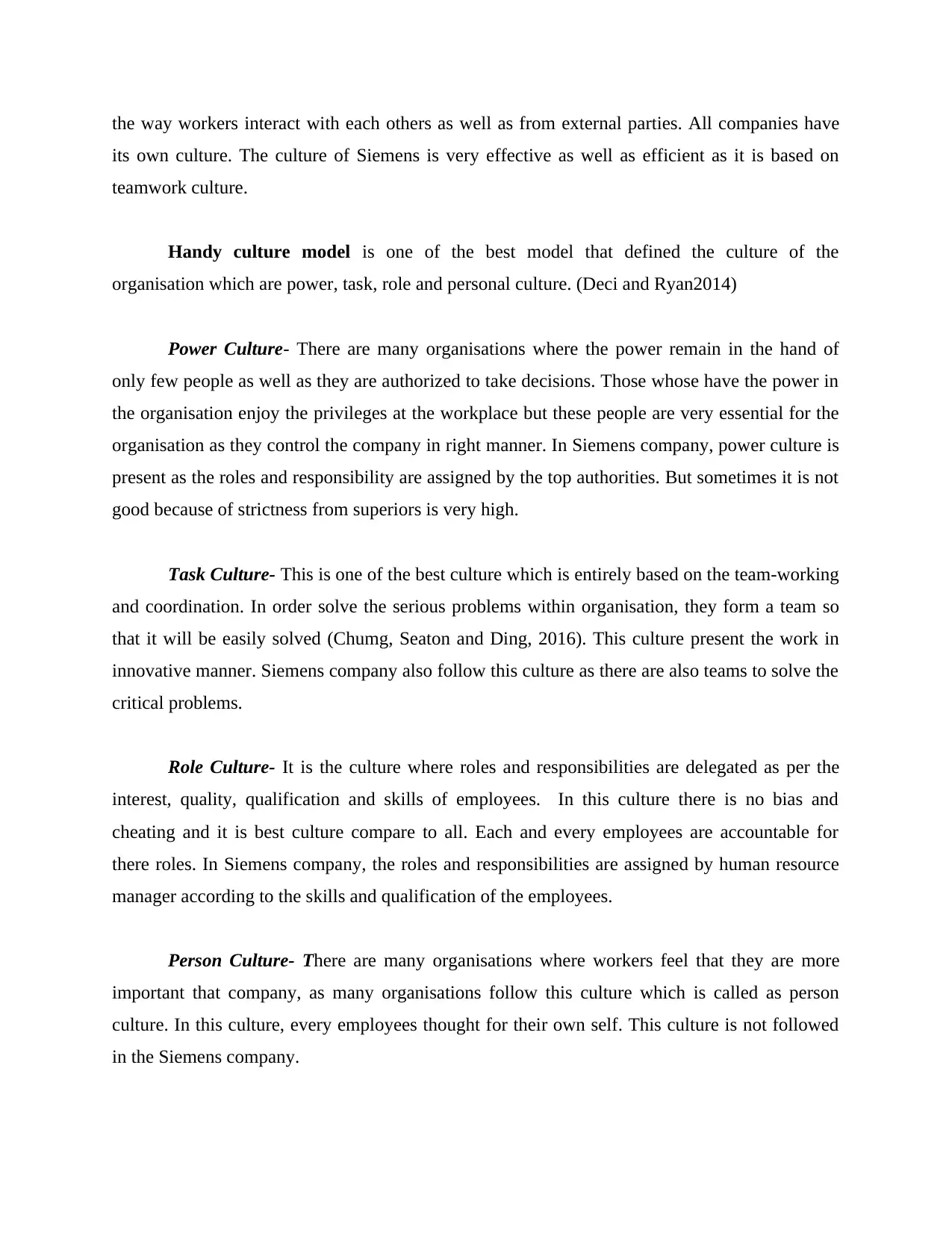
the way workers interact with each others as well as from external parties. All companies have
its own culture. The culture of Siemens is very effective as well as efficient as it is based on
teamwork culture.
Handy culture model is one of the best model that defined the culture of the
organisation which are power, task, role and personal culture. (Deci and Ryan2014)
Power Culture- There are many organisations where the power remain in the hand of
only few people as well as they are authorized to take decisions. Those whose have the power in
the organisation enjoy the privileges at the workplace but these people are very essential for the
organisation as they control the company in right manner. In Siemens company, power culture is
present as the roles and responsibility are assigned by the top authorities. But sometimes it is not
good because of strictness from superiors is very high.
Task Culture- This is one of the best culture which is entirely based on the team-working
and coordination. In order solve the serious problems within organisation, they form a team so
that it will be easily solved (Chumg, Seaton and Ding, 2016). This culture present the work in
innovative manner. Siemens company also follow this culture as there are also teams to solve the
critical problems.
Role Culture- It is the culture where roles and responsibilities are delegated as per the
interest, quality, qualification and skills of employees. In this culture there is no bias and
cheating and it is best culture compare to all. Each and every employees are accountable for
there roles. In Siemens company, the roles and responsibilities are assigned by human resource
manager according to the skills and qualification of the employees.
Person Culture- There are many organisations where workers feel that they are more
important that company, as many organisations follow this culture which is called as person
culture. In this culture, every employees thought for their own self. This culture is not followed
in the Siemens company.
its own culture. The culture of Siemens is very effective as well as efficient as it is based on
teamwork culture.
Handy culture model is one of the best model that defined the culture of the
organisation which are power, task, role and personal culture. (Deci and Ryan2014)
Power Culture- There are many organisations where the power remain in the hand of
only few people as well as they are authorized to take decisions. Those whose have the power in
the organisation enjoy the privileges at the workplace but these people are very essential for the
organisation as they control the company in right manner. In Siemens company, power culture is
present as the roles and responsibility are assigned by the top authorities. But sometimes it is not
good because of strictness from superiors is very high.
Task Culture- This is one of the best culture which is entirely based on the team-working
and coordination. In order solve the serious problems within organisation, they form a team so
that it will be easily solved (Chumg, Seaton and Ding, 2016). This culture present the work in
innovative manner. Siemens company also follow this culture as there are also teams to solve the
critical problems.
Role Culture- It is the culture where roles and responsibilities are delegated as per the
interest, quality, qualification and skills of employees. In this culture there is no bias and
cheating and it is best culture compare to all. Each and every employees are accountable for
there roles. In Siemens company, the roles and responsibilities are assigned by human resource
manager according to the skills and qualification of the employees.
Person Culture- There are many organisations where workers feel that they are more
important that company, as many organisations follow this culture which is called as person
culture. In this culture, every employees thought for their own self. This culture is not followed
in the Siemens company.
Paraphrase This Document
Need a fresh take? Get an instant paraphrase of this document with our AI Paraphraser
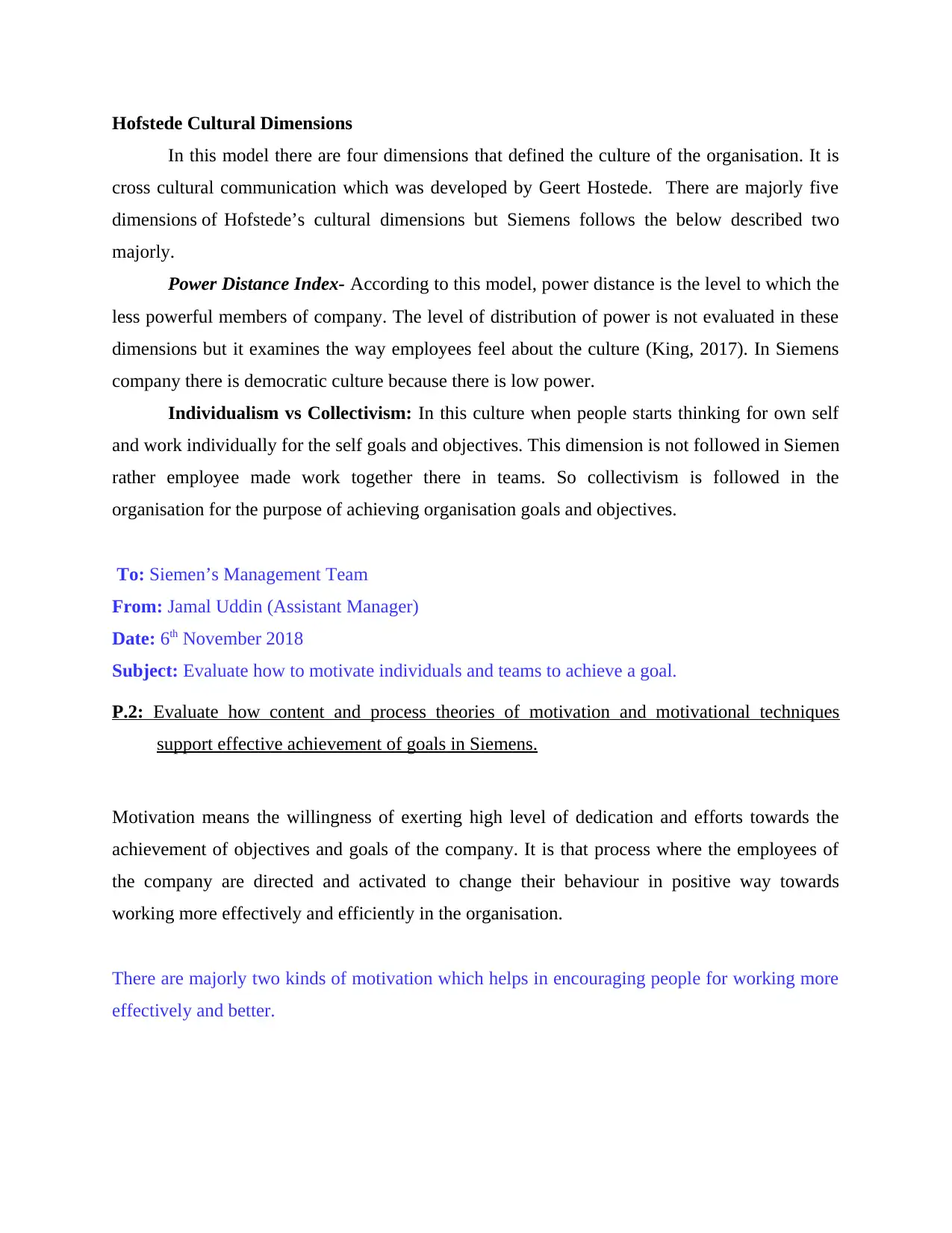
Hofstede Cultural Dimensions
In this model there are four dimensions that defined the culture of the organisation. It is
cross cultural communication which was developed by Geert Hostede. There are majorly five
dimensions of Hofstede’s cultural dimensions but Siemens follows the below described two
majorly.
Power Distance Index- According to this model, power distance is the level to which the
less powerful members of company. The level of distribution of power is not evaluated in these
dimensions but it examines the way employees feel about the culture (King, 2017). In Siemens
company there is democratic culture because there is low power.
Individualism vs Collectivism: In this culture when people starts thinking for own self
and work individually for the self goals and objectives. This dimension is not followed in Siemen
rather employee made work together there in teams. So collectivism is followed in the
organisation for the purpose of achieving organisation goals and objectives.
To: Siemen’s Management Team
From: Jamal Uddin (Assistant Manager)
Date: 6th November 2018
Subject: Evaluate how to motivate individuals and teams to achieve a goal.
P.2: Evaluate how content and process theories of motivation and motivational techniques
support effective achievement of goals in Siemens.
Motivation means the willingness of exerting high level of dedication and efforts towards the
achievement of objectives and goals of the company. It is that process where the employees of
the company are directed and activated to change their behaviour in positive way towards
working more effectively and efficiently in the organisation.
There are majorly two kinds of motivation which helps in encouraging people for working more
effectively and better.
In this model there are four dimensions that defined the culture of the organisation. It is
cross cultural communication which was developed by Geert Hostede. There are majorly five
dimensions of Hofstede’s cultural dimensions but Siemens follows the below described two
majorly.
Power Distance Index- According to this model, power distance is the level to which the
less powerful members of company. The level of distribution of power is not evaluated in these
dimensions but it examines the way employees feel about the culture (King, 2017). In Siemens
company there is democratic culture because there is low power.
Individualism vs Collectivism: In this culture when people starts thinking for own self
and work individually for the self goals and objectives. This dimension is not followed in Siemen
rather employee made work together there in teams. So collectivism is followed in the
organisation for the purpose of achieving organisation goals and objectives.
To: Siemen’s Management Team
From: Jamal Uddin (Assistant Manager)
Date: 6th November 2018
Subject: Evaluate how to motivate individuals and teams to achieve a goal.
P.2: Evaluate how content and process theories of motivation and motivational techniques
support effective achievement of goals in Siemens.
Motivation means the willingness of exerting high level of dedication and efforts towards the
achievement of objectives and goals of the company. It is that process where the employees of
the company are directed and activated to change their behaviour in positive way towards
working more effectively and efficiently in the organisation.
There are majorly two kinds of motivation which helps in encouraging people for working more
effectively and better.
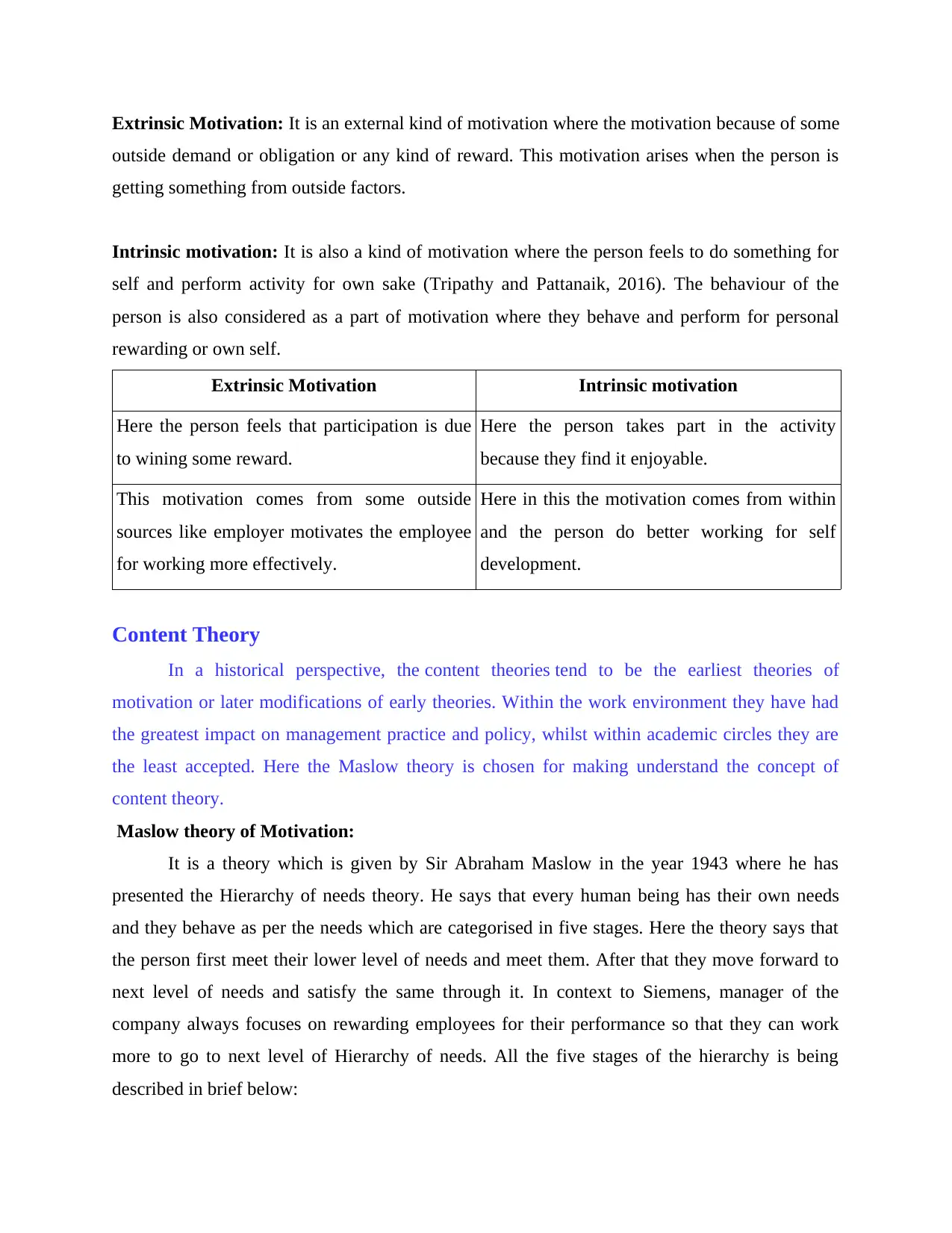
Extrinsic Motivation: It is an external kind of motivation where the motivation because of some
outside demand or obligation or any kind of reward. This motivation arises when the person is
getting something from outside factors.
Intrinsic motivation: It is also a kind of motivation where the person feels to do something for
self and perform activity for own sake (Tripathy and Pattanaik, 2016). The behaviour of the
person is also considered as a part of motivation where they behave and perform for personal
rewarding or own self.
Extrinsic Motivation Intrinsic motivation
Here the person feels that participation is due
to wining some reward.
Here the person takes part in the activity
because they find it enjoyable.
This motivation comes from some outside
sources like employer motivates the employee
for working more effectively.
Here in this the motivation comes from within
and the person do better working for self
development.
Content Theory
In a historical perspective, the content theories tend to be the earliest theories of
motivation or later modifications of early theories. Within the work environment they have had
the greatest impact on management practice and policy, whilst within academic circles they are
the least accepted. Here the Maslow theory is chosen for making understand the concept of
content theory.
Maslow theory of Motivation:
It is a theory which is given by Sir Abraham Maslow in the year 1943 where he has
presented the Hierarchy of needs theory. He says that every human being has their own needs
and they behave as per the needs which are categorised in five stages. Here the theory says that
the person first meet their lower level of needs and meet them. After that they move forward to
next level of needs and satisfy the same through it. In context to Siemens, manager of the
company always focuses on rewarding employees for their performance so that they can work
more to go to next level of Hierarchy of needs. All the five stages of the hierarchy is being
described in brief below:
outside demand or obligation or any kind of reward. This motivation arises when the person is
getting something from outside factors.
Intrinsic motivation: It is also a kind of motivation where the person feels to do something for
self and perform activity for own sake (Tripathy and Pattanaik, 2016). The behaviour of the
person is also considered as a part of motivation where they behave and perform for personal
rewarding or own self.
Extrinsic Motivation Intrinsic motivation
Here the person feels that participation is due
to wining some reward.
Here the person takes part in the activity
because they find it enjoyable.
This motivation comes from some outside
sources like employer motivates the employee
for working more effectively.
Here in this the motivation comes from within
and the person do better working for self
development.
Content Theory
In a historical perspective, the content theories tend to be the earliest theories of
motivation or later modifications of early theories. Within the work environment they have had
the greatest impact on management practice and policy, whilst within academic circles they are
the least accepted. Here the Maslow theory is chosen for making understand the concept of
content theory.
Maslow theory of Motivation:
It is a theory which is given by Sir Abraham Maslow in the year 1943 where he has
presented the Hierarchy of needs theory. He says that every human being has their own needs
and they behave as per the needs which are categorised in five stages. Here the theory says that
the person first meet their lower level of needs and meet them. After that they move forward to
next level of needs and satisfy the same through it. In context to Siemens, manager of the
company always focuses on rewarding employees for their performance so that they can work
more to go to next level of Hierarchy of needs. All the five stages of the hierarchy is being
described in brief below:
⊘ This is a preview!⊘
Do you want full access?
Subscribe today to unlock all pages.

Trusted by 1+ million students worldwide
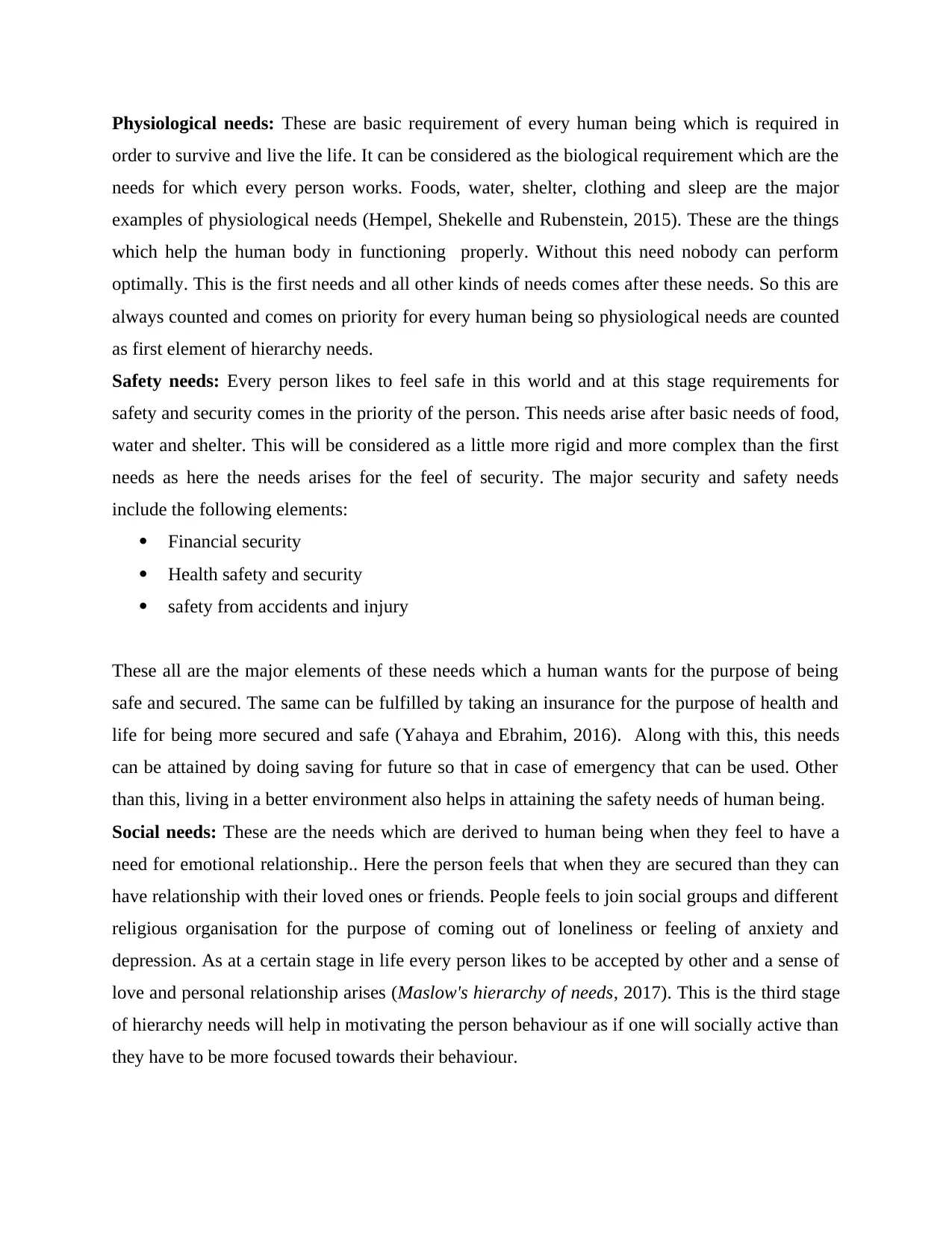
Physiological needs: These are basic requirement of every human being which is required in
order to survive and live the life. It can be considered as the biological requirement which are the
needs for which every person works. Foods, water, shelter, clothing and sleep are the major
examples of physiological needs (Hempel, Shekelle and Rubenstein, 2015). These are the things
which help the human body in functioning properly. Without this need nobody can perform
optimally. This is the first needs and all other kinds of needs comes after these needs. So this are
always counted and comes on priority for every human being so physiological needs are counted
as first element of hierarchy needs.
Safety needs: Every person likes to feel safe in this world and at this stage requirements for
safety and security comes in the priority of the person. This needs arise after basic needs of food,
water and shelter. This will be considered as a little more rigid and more complex than the first
needs as here the needs arises for the feel of security. The major security and safety needs
include the following elements:
Financial security
Health safety and security
safety from accidents and injury
These all are the major elements of these needs which a human wants for the purpose of being
safe and secured. The same can be fulfilled by taking an insurance for the purpose of health and
life for being more secured and safe (Yahaya and Ebrahim, 2016). Along with this, this needs
can be attained by doing saving for future so that in case of emergency that can be used. Other
than this, living in a better environment also helps in attaining the safety needs of human being.
Social needs: These are the needs which are derived to human being when they feel to have a
need for emotional relationship.. Here the person feels that when they are secured than they can
have relationship with their loved ones or friends. People feels to join social groups and different
religious organisation for the purpose of coming out of loneliness or feeling of anxiety and
depression. As at a certain stage in life every person likes to be accepted by other and a sense of
love and personal relationship arises (Maslow's hierarchy of needs, 2017). This is the third stage
of hierarchy needs will help in motivating the person behaviour as if one will socially active than
they have to be more focused towards their behaviour.
order to survive and live the life. It can be considered as the biological requirement which are the
needs for which every person works. Foods, water, shelter, clothing and sleep are the major
examples of physiological needs (Hempel, Shekelle and Rubenstein, 2015). These are the things
which help the human body in functioning properly. Without this need nobody can perform
optimally. This is the first needs and all other kinds of needs comes after these needs. So this are
always counted and comes on priority for every human being so physiological needs are counted
as first element of hierarchy needs.
Safety needs: Every person likes to feel safe in this world and at this stage requirements for
safety and security comes in the priority of the person. This needs arise after basic needs of food,
water and shelter. This will be considered as a little more rigid and more complex than the first
needs as here the needs arises for the feel of security. The major security and safety needs
include the following elements:
Financial security
Health safety and security
safety from accidents and injury
These all are the major elements of these needs which a human wants for the purpose of being
safe and secured. The same can be fulfilled by taking an insurance for the purpose of health and
life for being more secured and safe (Yahaya and Ebrahim, 2016). Along with this, this needs
can be attained by doing saving for future so that in case of emergency that can be used. Other
than this, living in a better environment also helps in attaining the safety needs of human being.
Social needs: These are the needs which are derived to human being when they feel to have a
need for emotional relationship.. Here the person feels that when they are secured than they can
have relationship with their loved ones or friends. People feels to join social groups and different
religious organisation for the purpose of coming out of loneliness or feeling of anxiety and
depression. As at a certain stage in life every person likes to be accepted by other and a sense of
love and personal relationship arises (Maslow's hierarchy of needs, 2017). This is the third stage
of hierarchy needs will help in motivating the person behaviour as if one will socially active than
they have to be more focused towards their behaviour.
Paraphrase This Document
Need a fresh take? Get an instant paraphrase of this document with our AI Paraphraser
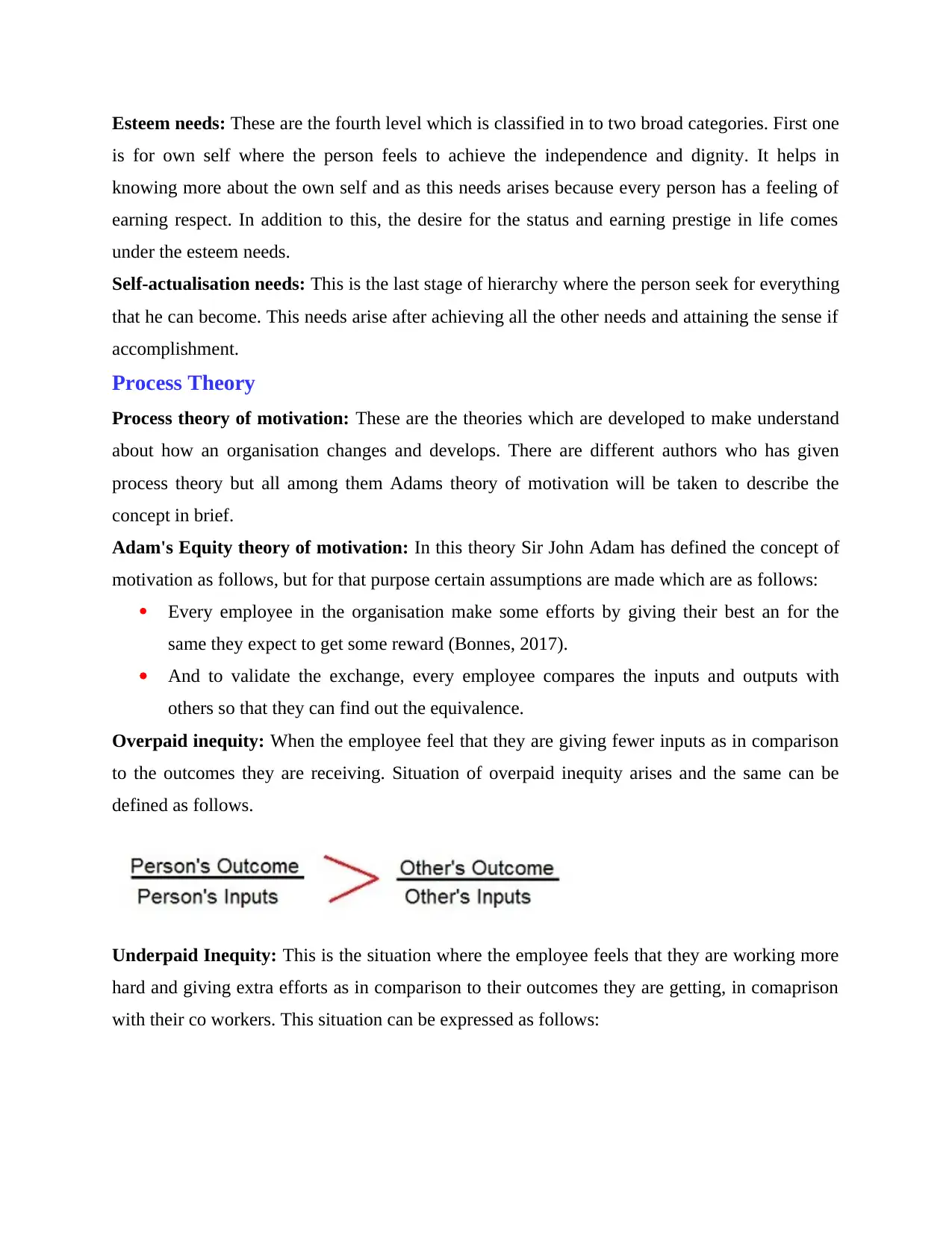
Esteem needs: These are the fourth level which is classified in to two broad categories. First one
is for own self where the person feels to achieve the independence and dignity. It helps in
knowing more about the own self and as this needs arises because every person has a feeling of
earning respect. In addition to this, the desire for the status and earning prestige in life comes
under the esteem needs.
Self-actualisation needs: This is the last stage of hierarchy where the person seek for everything
that he can become. This needs arise after achieving all the other needs and attaining the sense if
accomplishment.
Process Theory
Process theory of motivation: These are the theories which are developed to make understand
about how an organisation changes and develops. There are different authors who has given
process theory but all among them Adams theory of motivation will be taken to describe the
concept in brief.
Adam's Equity theory of motivation: In this theory Sir John Adam has defined the concept of
motivation as follows, but for that purpose certain assumptions are made which are as follows:
Every employee in the organisation make some efforts by giving their best an for the
same they expect to get some reward (Bonnes, 2017).
And to validate the exchange, every employee compares the inputs and outputs with
others so that they can find out the equivalence.
Overpaid inequity: When the employee feel that they are giving fewer inputs as in comparison
to the outcomes they are receiving. Situation of overpaid inequity arises and the same can be
defined as follows.
Underpaid Inequity: This is the situation where the employee feels that they are working more
hard and giving extra efforts as in comparison to their outcomes they are getting, in comaprison
with their co workers. This situation can be expressed as follows:
is for own self where the person feels to achieve the independence and dignity. It helps in
knowing more about the own self and as this needs arises because every person has a feeling of
earning respect. In addition to this, the desire for the status and earning prestige in life comes
under the esteem needs.
Self-actualisation needs: This is the last stage of hierarchy where the person seek for everything
that he can become. This needs arise after achieving all the other needs and attaining the sense if
accomplishment.
Process Theory
Process theory of motivation: These are the theories which are developed to make understand
about how an organisation changes and develops. There are different authors who has given
process theory but all among them Adams theory of motivation will be taken to describe the
concept in brief.
Adam's Equity theory of motivation: In this theory Sir John Adam has defined the concept of
motivation as follows, but for that purpose certain assumptions are made which are as follows:
Every employee in the organisation make some efforts by giving their best an for the
same they expect to get some reward (Bonnes, 2017).
And to validate the exchange, every employee compares the inputs and outputs with
others so that they can find out the equivalence.
Overpaid inequity: When the employee feel that they are giving fewer inputs as in comparison
to the outcomes they are receiving. Situation of overpaid inequity arises and the same can be
defined as follows.
Underpaid Inequity: This is the situation where the employee feels that they are working more
hard and giving extra efforts as in comparison to their outcomes they are getting, in comaprison
with their co workers. This situation can be expressed as follows:
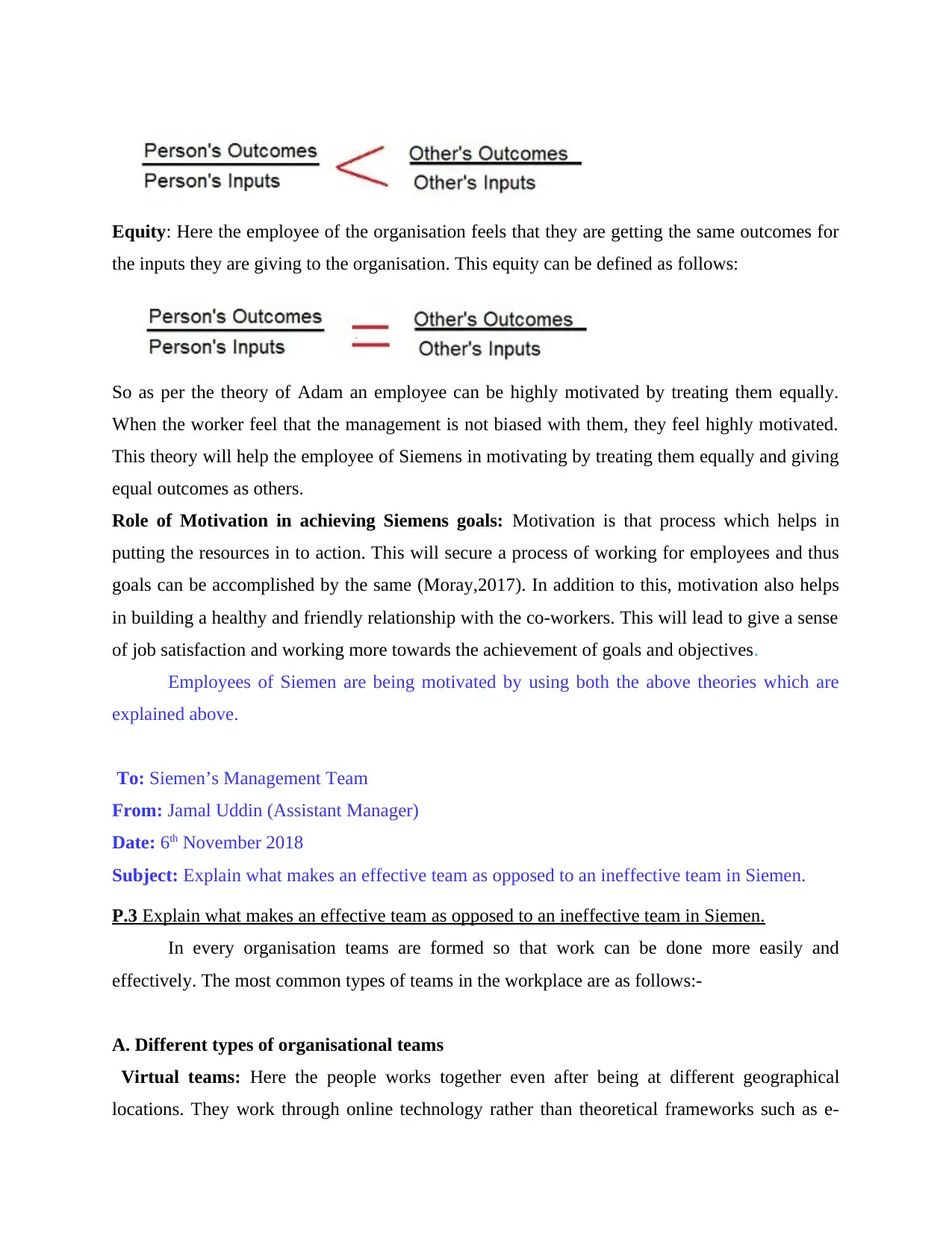
Equity: Here the employee of the organisation feels that they are getting the same outcomes for
the inputs they are giving to the organisation. This equity can be defined as follows:
So as per the theory of Adam an employee can be highly motivated by treating them equally.
When the worker feel that the management is not biased with them, they feel highly motivated.
This theory will help the employee of Siemens in motivating by treating them equally and giving
equal outcomes as others.
Role of Motivation in achieving Siemens goals: Motivation is that process which helps in
putting the resources in to action. This will secure a process of working for employees and thus
goals can be accomplished by the same (Moray,2017). In addition to this, motivation also helps
in building a healthy and friendly relationship with the co-workers. This will lead to give a sense
of job satisfaction and working more towards the achievement of goals and objectives.
Employees of Siemen are being motivated by using both the above theories which are
explained above.
To: Siemen’s Management Team
From: Jamal Uddin (Assistant Manager)
Date: 6th November 2018
Subject: Explain what makes an effective team as opposed to an ineffective team in Siemen.
P.3 Explain what makes an effective team as opposed to an ineffective team in Siemen.
In every organisation teams are formed so that work can be done more easily and
effectively. The most common types of teams in the workplace are as follows:-
A. Different types of organisational teams
Virtual teams: Here the people works together even after being at different geographical
locations. They work through online technology rather than theoretical frameworks such as e-
the inputs they are giving to the organisation. This equity can be defined as follows:
So as per the theory of Adam an employee can be highly motivated by treating them equally.
When the worker feel that the management is not biased with them, they feel highly motivated.
This theory will help the employee of Siemens in motivating by treating them equally and giving
equal outcomes as others.
Role of Motivation in achieving Siemens goals: Motivation is that process which helps in
putting the resources in to action. This will secure a process of working for employees and thus
goals can be accomplished by the same (Moray,2017). In addition to this, motivation also helps
in building a healthy and friendly relationship with the co-workers. This will lead to give a sense
of job satisfaction and working more towards the achievement of goals and objectives.
Employees of Siemen are being motivated by using both the above theories which are
explained above.
To: Siemen’s Management Team
From: Jamal Uddin (Assistant Manager)
Date: 6th November 2018
Subject: Explain what makes an effective team as opposed to an ineffective team in Siemen.
P.3 Explain what makes an effective team as opposed to an ineffective team in Siemen.
In every organisation teams are formed so that work can be done more easily and
effectively. The most common types of teams in the workplace are as follows:-
A. Different types of organisational teams
Virtual teams: Here the people works together even after being at different geographical
locations. They work through online technology rather than theoretical frameworks such as e-
⊘ This is a preview!⊘
Do you want full access?
Subscribe today to unlock all pages.

Trusted by 1+ million students worldwide
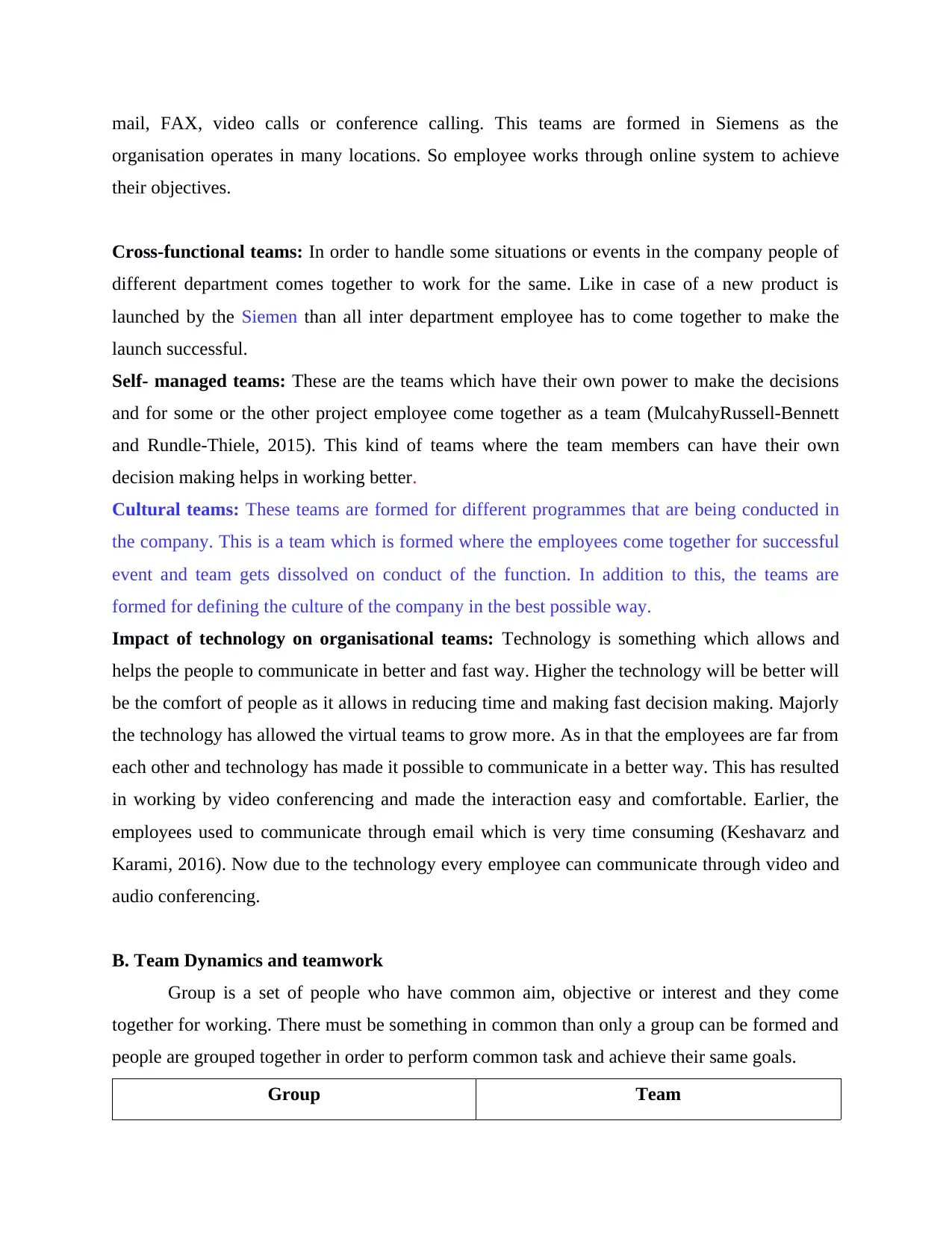
mail, FAX, video calls or conference calling. This teams are formed in Siemens as the
organisation operates in many locations. So employee works through online system to achieve
their objectives.
Cross-functional teams: In order to handle some situations or events in the company people of
different department comes together to work for the same. Like in case of a new product is
launched by the Siemen than all inter department employee has to come together to make the
launch successful.
Self- managed teams: These are the teams which have their own power to make the decisions
and for some or the other project employee come together as a team (MulcahyRussell-Bennett
and Rundle-Thiele, 2015). This kind of teams where the team members can have their own
decision making helps in working better.
Cultural teams: These teams are formed for different programmes that are being conducted in
the company. This is a team which is formed where the employees come together for successful
event and team gets dissolved on conduct of the function. In addition to this, the teams are
formed for defining the culture of the company in the best possible way.
Impact of technology on organisational teams: Technology is something which allows and
helps the people to communicate in better and fast way. Higher the technology will be better will
be the comfort of people as it allows in reducing time and making fast decision making. Majorly
the technology has allowed the virtual teams to grow more. As in that the employees are far from
each other and technology has made it possible to communicate in a better way. This has resulted
in working by video conferencing and made the interaction easy and comfortable. Earlier, the
employees used to communicate through email which is very time consuming (Keshavarz and
Karami, 2016). Now due to the technology every employee can communicate through video and
audio conferencing.
B. Team Dynamics and teamwork
Group is a set of people who have common aim, objective or interest and they come
together for working. There must be something in common than only a group can be formed and
people are grouped together in order to perform common task and achieve their same goals.
Group Team
organisation operates in many locations. So employee works through online system to achieve
their objectives.
Cross-functional teams: In order to handle some situations or events in the company people of
different department comes together to work for the same. Like in case of a new product is
launched by the Siemen than all inter department employee has to come together to make the
launch successful.
Self- managed teams: These are the teams which have their own power to make the decisions
and for some or the other project employee come together as a team (MulcahyRussell-Bennett
and Rundle-Thiele, 2015). This kind of teams where the team members can have their own
decision making helps in working better.
Cultural teams: These teams are formed for different programmes that are being conducted in
the company. This is a team which is formed where the employees come together for successful
event and team gets dissolved on conduct of the function. In addition to this, the teams are
formed for defining the culture of the company in the best possible way.
Impact of technology on organisational teams: Technology is something which allows and
helps the people to communicate in better and fast way. Higher the technology will be better will
be the comfort of people as it allows in reducing time and making fast decision making. Majorly
the technology has allowed the virtual teams to grow more. As in that the employees are far from
each other and technology has made it possible to communicate in a better way. This has resulted
in working by video conferencing and made the interaction easy and comfortable. Earlier, the
employees used to communicate through email which is very time consuming (Keshavarz and
Karami, 2016). Now due to the technology every employee can communicate through video and
audio conferencing.
B. Team Dynamics and teamwork
Group is a set of people who have common aim, objective or interest and they come
together for working. There must be something in common than only a group can be formed and
people are grouped together in order to perform common task and achieve their same goals.
Group Team
Paraphrase This Document
Need a fresh take? Get an instant paraphrase of this document with our AI Paraphraser
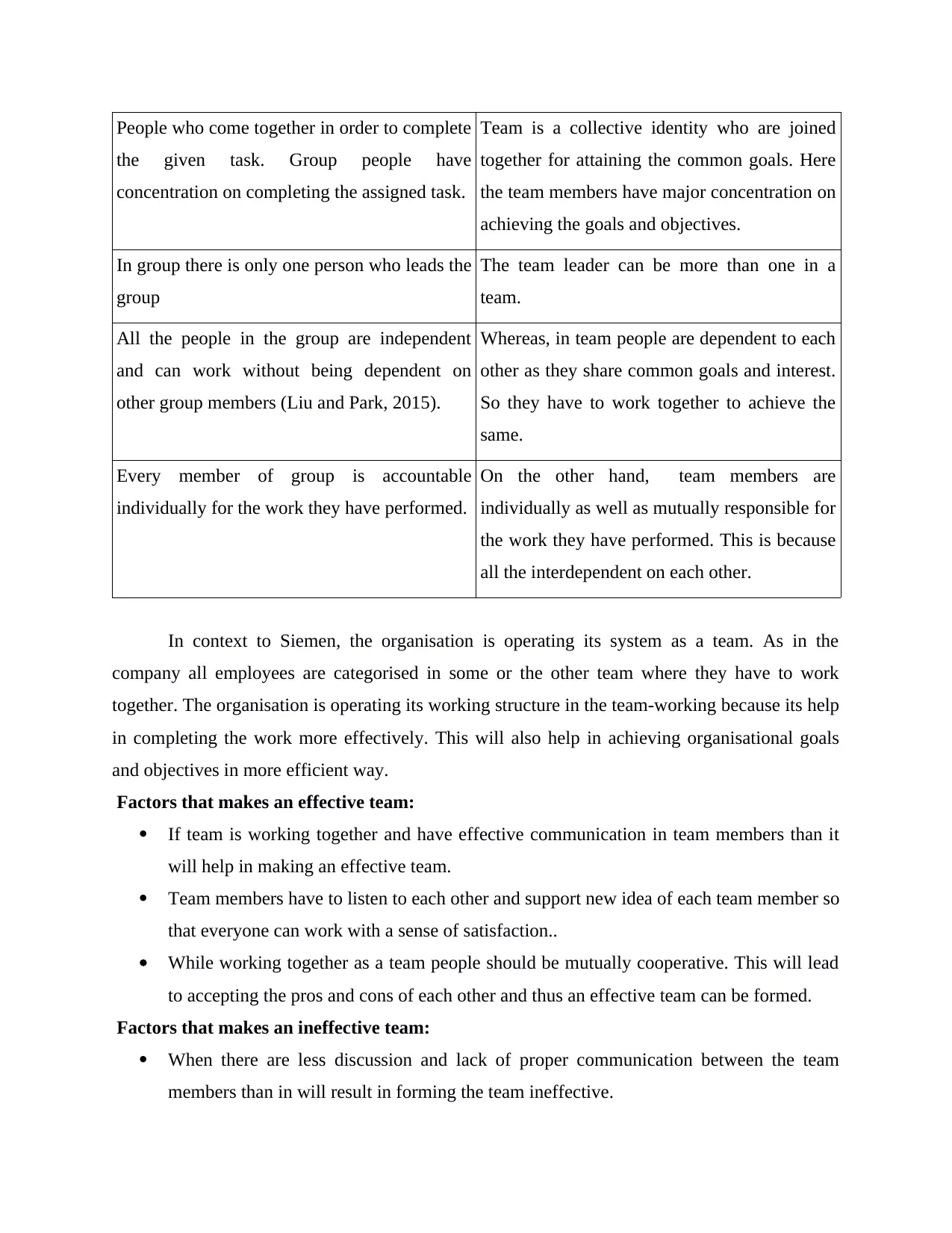
People who come together in order to complete
the given task. Group people have
concentration on completing the assigned task.
Team is a collective identity who are joined
together for attaining the common goals. Here
the team members have major concentration on
achieving the goals and objectives.
In group there is only one person who leads the
group
The team leader can be more than one in a
team.
All the people in the group are independent
and can work without being dependent on
other group members (Liu and Park, 2015).
Whereas, in team people are dependent to each
other as they share common goals and interest.
So they have to work together to achieve the
same.
Every member of group is accountable
individually for the work they have performed.
On the other hand, team members are
individually as well as mutually responsible for
the work they have performed. This is because
all the interdependent on each other.
In context to Siemen, the organisation is operating its system as a team. As in the
company all employees are categorised in some or the other team where they have to work
together. The organisation is operating its working structure in the team-working because its help
in completing the work more effectively. This will also help in achieving organisational goals
and objectives in more efficient way.
Factors that makes an effective team:
If team is working together and have effective communication in team members than it
will help in making an effective team.
Team members have to listen to each other and support new idea of each team member so
that everyone can work with a sense of satisfaction..
While working together as a team people should be mutually cooperative. This will lead
to accepting the pros and cons of each other and thus an effective team can be formed.
Factors that makes an ineffective team:
When there are less discussion and lack of proper communication between the team
members than in will result in forming the team ineffective.
the given task. Group people have
concentration on completing the assigned task.
Team is a collective identity who are joined
together for attaining the common goals. Here
the team members have major concentration on
achieving the goals and objectives.
In group there is only one person who leads the
group
The team leader can be more than one in a
team.
All the people in the group are independent
and can work without being dependent on
other group members (Liu and Park, 2015).
Whereas, in team people are dependent to each
other as they share common goals and interest.
So they have to work together to achieve the
same.
Every member of group is accountable
individually for the work they have performed.
On the other hand, team members are
individually as well as mutually responsible for
the work they have performed. This is because
all the interdependent on each other.
In context to Siemen, the organisation is operating its system as a team. As in the
company all employees are categorised in some or the other team where they have to work
together. The organisation is operating its working structure in the team-working because its help
in completing the work more effectively. This will also help in achieving organisational goals
and objectives in more efficient way.
Factors that makes an effective team:
If team is working together and have effective communication in team members than it
will help in making an effective team.
Team members have to listen to each other and support new idea of each team member so
that everyone can work with a sense of satisfaction..
While working together as a team people should be mutually cooperative. This will lead
to accepting the pros and cons of each other and thus an effective team can be formed.
Factors that makes an ineffective team:
When there are less discussion and lack of proper communication between the team
members than in will result in forming the team ineffective.
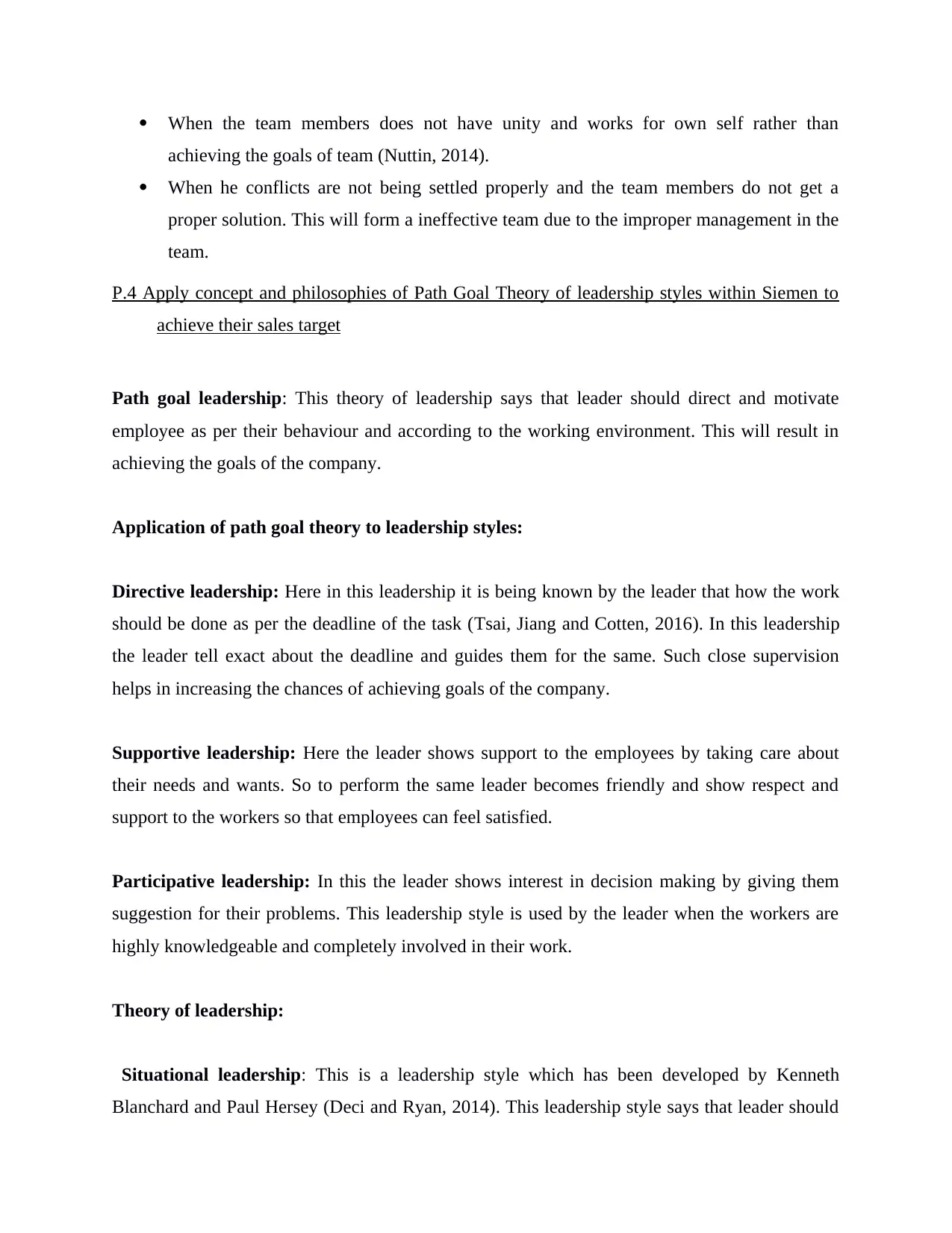
When the team members does not have unity and works for own self rather than
achieving the goals of team (Nuttin, 2014).
When he conflicts are not being settled properly and the team members do not get a
proper solution. This will form a ineffective team due to the improper management in the
team.
P.4 Apply concept and philosophies of Path Goal Theory of leadership styles within Siemen to
achieve their sales target
Path goal leadership: This theory of leadership says that leader should direct and motivate
employee as per their behaviour and according to the working environment. This will result in
achieving the goals of the company.
Application of path goal theory to leadership styles:
Directive leadership: Here in this leadership it is being known by the leader that how the work
should be done as per the deadline of the task (Tsai, Jiang and Cotten, 2016). In this leadership
the leader tell exact about the deadline and guides them for the same. Such close supervision
helps in increasing the chances of achieving goals of the company.
Supportive leadership: Here the leader shows support to the employees by taking care about
their needs and wants. So to perform the same leader becomes friendly and show respect and
support to the workers so that employees can feel satisfied.
Participative leadership: In this the leader shows interest in decision making by giving them
suggestion for their problems. This leadership style is used by the leader when the workers are
highly knowledgeable and completely involved in their work.
Theory of leadership:
Situational leadership: This is a leadership style which has been developed by Kenneth
Blanchard and Paul Hersey (Deci and Ryan, 2014). This leadership style says that leader should
achieving the goals of team (Nuttin, 2014).
When he conflicts are not being settled properly and the team members do not get a
proper solution. This will form a ineffective team due to the improper management in the
team.
P.4 Apply concept and philosophies of Path Goal Theory of leadership styles within Siemen to
achieve their sales target
Path goal leadership: This theory of leadership says that leader should direct and motivate
employee as per their behaviour and according to the working environment. This will result in
achieving the goals of the company.
Application of path goal theory to leadership styles:
Directive leadership: Here in this leadership it is being known by the leader that how the work
should be done as per the deadline of the task (Tsai, Jiang and Cotten, 2016). In this leadership
the leader tell exact about the deadline and guides them for the same. Such close supervision
helps in increasing the chances of achieving goals of the company.
Supportive leadership: Here the leader shows support to the employees by taking care about
their needs and wants. So to perform the same leader becomes friendly and show respect and
support to the workers so that employees can feel satisfied.
Participative leadership: In this the leader shows interest in decision making by giving them
suggestion for their problems. This leadership style is used by the leader when the workers are
highly knowledgeable and completely involved in their work.
Theory of leadership:
Situational leadership: This is a leadership style which has been developed by Kenneth
Blanchard and Paul Hersey (Deci and Ryan, 2014). This leadership style says that leader should
⊘ This is a preview!⊘
Do you want full access?
Subscribe today to unlock all pages.

Trusted by 1+ million students worldwide
1 out of 16
Related Documents
Your All-in-One AI-Powered Toolkit for Academic Success.
+13062052269
info@desklib.com
Available 24*7 on WhatsApp / Email
![[object Object]](/_next/static/media/star-bottom.7253800d.svg)
Unlock your academic potential
Copyright © 2020–2025 A2Z Services. All Rights Reserved. Developed and managed by ZUCOL.




